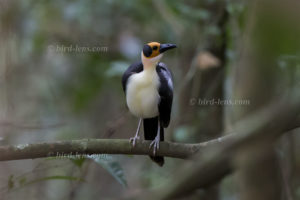 In March 2019 I visited Ghana with Birdquest specifically to search for the White-necked Rockfowl – or Yellow-headed Picathartes – (Picathartes gymnocephalus). Previously, colonies of this bird sought by many avian enthusiasts had been recorded throughout the rainforest zone of western Africa. Ceaseless deforestation destroyed all known populations, and the bird was considered extinct in Ghana a few decades ago.
In March 2019 I visited Ghana with Birdquest specifically to search for the White-necked Rockfowl – or Yellow-headed Picathartes – (Picathartes gymnocephalus). Previously, colonies of this bird sought by many avian enthusiasts had been recorded throughout the rainforest zone of western Africa. Ceaseless deforestation destroyed all known populations, and the bird was considered extinct in Ghana a few decades ago.
However, scientists suspected that they still existed in hard-to-reach places and tried to look for suitable spots in the interior of West Africa. The hope was confirmed when several indigenous hunters responded on appropriate questions that they knew the bird and claimed that they still existed. Then a few years ago the news broke that picathartes had been rediscovered in Ghana at a community forest reserve.
Researchers studied the environment and discovered several more colonies. Some of these colonies were opened to tourism after researchers found that responsible birdwatchers are perceived by the birds to be of little disturbance.
The White-necked Rockfowl is somewhat misnamed as it has both a yellow neck and head but the name is presumably inspired by the dried and colorless corpses to be found in museum collections.
For this reason, we traveled over half a day from the coast at Cape Coast to the remote village of Bonkro in the southern central region of Ghana. Here native hunters, who knew about the colony for generations, had already “harvested” the birds. They simply picked the adult birds out of their nests during the breeding season. Now that the colony is closed to hunting, the population of the Yellow-headed Picathartes has increased greatly and the village is profiting enormously from entry and guiding fees. It was even a school is built with means of conservation
We arrived in the afternoon and once we had met our local village guide and managed to escape the friendly throngs of children, we walked through fields of cocoa, corn and other crops. You might feel that these fields had recently been primary rainforest. We walked a relatively easy although undulating uphill walk. There were several good birds to be seen along the way for firstly some low-flying Black Spinetail (Telacanthura melanopygia) were watched circling low over the farmbush at the forest edge. Finally we slipped into the dark forest and followed a meandering trail for 2 km, passing massive forest giants with expansive buttress roots, until we reached a very steep rise. After managing a sweaty climb of 100 – 150 meters or so, before we lay the colony of mud cup-shaped nests stuck against the walls of a rock overhand. We quietly settled on an improvised bench near the massive boulder and waited. Picathartes spend their days hopping over the shady forest floor and over mossy rocks and lianas. They are looking for insects, snails and other prey. They also attend swarms of army ants to prey on insects they might flush. Very little is known of their behavior away from their nests as they are incredibly shy birds, disappearing at the first signs of disturbance. However, around their colonies – to which they usually return each evening – they seem to lose their fear, perching close to observers to preen, sometimes ignoring people and at other times displaying great curiosity. We were sitting approx. 2 hours very quietly.
The tension and excitement was mounting with every minute. But again and again we had to settle on the hard wooden bench. Suddenly at 5:15 p.m. the first bird came out of nowhere. Suddenly the bird was seen on a strong horizontal branch a little deeper in the forest. At first, the Picathartes stood motionless on the branch. The bird started intensively preening on its perch. Everyone involved had the relief in mind to finally see these incredible creatures. The feeling was immense.
After a while the Picathartes, who had been preening, left its branch and moved towards the nests under the boulder. Then other birds came and stayed for a while at their nests and under the boulder. It was already dawn when the first bird landed with an impressive jump in it’s – for its size – tiny nest. All in all we enjoyed a marvelous and unforgettable encounter with these wonderful birds.
Further to the south, the Grey-necked or Red-headed Picathartes (Picathartes oreas) has a wider range along the Gulf of Guinea. It occurs from south-west Nigeria, Equatorial Guinea, Cameroon and Gabon. Its ecology and behavior is much like that of its slightly larger cousin. I have only seen this species in the massive and beautiful Campo Maan National Park in Cameroon. Another option is the Korup National Park. But reaching this site involves quite an ordeal, including driving or boating close to the Nigerian border, then crossing a massive swing bridge over the Mana River and hiking 6 miles to Picathartes Knoll, where a colony of these fabulous birds exist. Again, they are best seen in the late evening when they sometimes return to roost close to their nests.
To cope with the growing demand for top shots of the rarer species of the Palearctic Bird-Lens is keen to enrich the range of pictures of birds not only in the western Palearctic. Trips to remote places like this one to capture images were very successful. The nice image of the blog is only a first impression, what you will find in the gallery in the “Picture Shop” very soon. Just give bird-lens.com a message, if www.bird-lens.com could serve you with an image needed before the new pictures are online.
Tag: